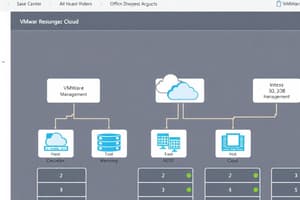Podcast
Questions and Answers
What is a key advantage of using cloud infrastructure regarding resource management?
What is a key advantage of using cloud infrastructure regarding resource management?
- Physical hardware needs to be maintained always.
- Resource allocation cannot be adjusted dynamically.
- Only one tenant can use a given resource at a time.
- Cloud providers can overcommit resources. (correct)
Containerization provides the illusion of a complete machine environment similar to virtual machines.
Containerization provides the illusion of a complete machine environment similar to virtual machines.
False (B)
What technique does the Linux kernel use to enable container implementation?
What technique does the Linux kernel use to enable container implementation?
cgroup subsystem
Containers are isolated from the rest of the system in terms of resource access, allowing them to use only a subset of the _______.
Containers are isolated from the rest of the system in terms of resource access, allowing them to use only a subset of the _______.
Match the following benefits with their corresponding virtualization technique:
Match the following benefits with their corresponding virtualization technique:
Which of the following statements about virtual machines (VMs) is true?
Which of the following statements about virtual machines (VMs) is true?
In a container, processes can send signals to other processes running outside of the container.
In a container, processes can send signals to other processes running outside of the container.
What architectural feature allows for the pooling of resources among tenants in cloud providers?
What architectural feature allows for the pooling of resources among tenants in cloud providers?
What method does a hypervisor use for managing device control and configuration?
What method does a hypervisor use for managing device control and configuration?
Passthrough is primarily used for device control and configuration.
Passthrough is primarily used for device control and configuration.
Name one advantage of using virtual machines in cloud environments.
Name one advantage of using virtual machines in cloud environments.
In virtualization, the hypervisor allocates the device context to different __________ when necessary.
In virtualization, the hypervisor allocates the device context to different __________ when necessary.
Match the virtualization techniques with their descriptions:
Match the virtualization techniques with their descriptions:
Which of the following is a type of cloud infrastructure?
Which of the following is a type of cloud infrastructure?
Virtual machines cannot be moved around between different machines or cloud providers.
Virtual machines cannot be moved around between different machines or cloud providers.
What is the purpose of the 'trap and emulate' method in virtualization?
What is the purpose of the 'trap and emulate' method in virtualization?
In virtualization, the hypervisor can maintain near-native performance for __________ operations.
In virtualization, the hypervisor can maintain near-native performance for __________ operations.
What is a key difference between containerization and virtualization?
What is a key difference between containerization and virtualization?
What is the role of a hypervisor?
What is the role of a hypervisor?
In a hypervisor environment, VMs are unaware that they are running on a virtualized system.
In a hypervisor environment, VMs are unaware that they are running on a virtualized system.
Name one advantage of using cloud infrastructure over traditional data centers.
Name one advantage of using cloud infrastructure over traditional data centers.
The hypervisor operates at __________ level and interacts with both hardware and guest OS.
The hypervisor operates at __________ level and interacts with both hardware and guest OS.
Match the hypervisor type with its characteristic:
Match the hypervisor type with its characteristic:
What is the primary function of a hypervisor?
What is the primary function of a hypervisor?
The hypervisor is referred to as the guest in virtualization.
The hypervisor is referred to as the guest in virtualization.
What term describes the illusion of running multiple operating systems on a single physical machine?
What term describes the illusion of running multiple operating systems on a single physical machine?
The software component that creates the illusion of multiple virtual machines is called a __________.
The software component that creates the illusion of multiple virtual machines is called a __________.
Match the virtualization terms with their definitions:
Match the virtualization terms with their definitions:
Which of the following is an advantage of cloud infrastructure provided by virtualization?
Which of the following is an advantage of cloud infrastructure provided by virtualization?
Containerization allows for running multiple instances of the same operating system on a single machine.
Containerization allows for running multiple instances of the same operating system on a single machine.
What term is used to refer to the lightweight approach to virtualization that uses containers?
What term is used to refer to the lightweight approach to virtualization that uses containers?
Virtualization allows businesses to optimize __________ and improve resource utilization.
Virtualization allows businesses to optimize __________ and improve resource utilization.
Match the following virtualization deployment models with their descriptions:
Match the following virtualization deployment models with their descriptions:
What is one of the main advantages of using virtualization?
What is one of the main advantages of using virtualization?
Virtual machines can only be hosted on separate physical machines.
Virtual machines can only be hosted on separate physical machines.
Name one requirement that a hypervisor must fulfill for virtual machines.
Name one requirement that a hypervisor must fulfill for virtual machines.
Virtual machines should be able to boot and run transparently as if alone on a(n) ______.
Virtual machines should be able to boot and run transparently as if alone on a(n) ______.
Match the following hypervisor features with their descriptions:
Match the following hypervisor features with their descriptions:
What does the term 'migration' refer to in virtual machine technology?
What does the term 'migration' refer to in virtual machine technology?
Hardware-based solutions for hypervisors are less efficient than software-based solutions.
Hardware-based solutions for hypervisors are less efficient than software-based solutions.
What is an example of a software-based technique used by hypervisors?
What is an example of a software-based technique used by hypervisors?
Virtualization allows for ______ consumption reduction by consolidating multiple VMs.
Virtualization allows for ______ consumption reduction by consolidating multiple VMs.
Which of the following is NOT a requirement for a hypervisor?
Which of the following is NOT a requirement for a hypervisor?
Virtualization allows a single physical machine to serve multiple virtual machines effectively.
Virtualization allows a single physical machine to serve multiple virtual machines effectively.
Flashcards are hidden until you start studying
Study Notes
Virtualization Overview
- Virtualization creates the appearance of multiple virtual machines (VMs) on a single physical machine.
- A Virtual Machine Monitor (VMM), or hypervisor, is responsible for managing VMs and allowing different operating systems to run simultaneously.
- Cloud providers can efficiently pool and allocate resources,like CPU and memory, by overcommitting resources.
Containers
- Containers provide an isolated user space environment, differing from standard VMs.
- Containers restrict resource access, allowing them to use only a defined portion of system resources like CPU and memory.
- Resource visibility is limited in containers—they can only see a subset of the file system and processes within their environment.
- The Linux kernel employs the cgroup subsystem to facilitate container implementation.
Advantages of Virtualization
- VMs enhance safety; a failure in one VM does not impact others.
- Resource consolidation minimizes waste and energy consumption by running multiple VMs on a single server.
- Migration allows easy movement of VMs between physical machines, facilitating load balancing and resource optimization.
Hypervisor Operations
- Hypervisors mediate device control through emulation for configuration tasks while allowing data passthrough for performance efficiency.
- They must ensure three key requirements: safety (strong isolation), fidelity (consistent behavior as on physical machines), and efficiency (minimal hypervisor intervention).
Hypervisor Technologies
- Software-based hypervisors interpret instructions from the VM, executing them through the hypervisor interface. Examples include Xen and VMware ESXi.
- Hardware virtualization enables VMs to operate as though they were on bare metal, maintaining the illusion of direct hardware access for the user process.
Deployment Models
- Virtual machines are widely used in both public and private cloud infrastructures, such as AWS, Google Cloud, and Microsoft Azure.
- VMs can be deployed anywhere on machines with hypervisors, facilitating flexible application deployment and management.
Studying That Suits You
Use AI to generate personalized quizzes and flashcards to suit your learning preferences.




